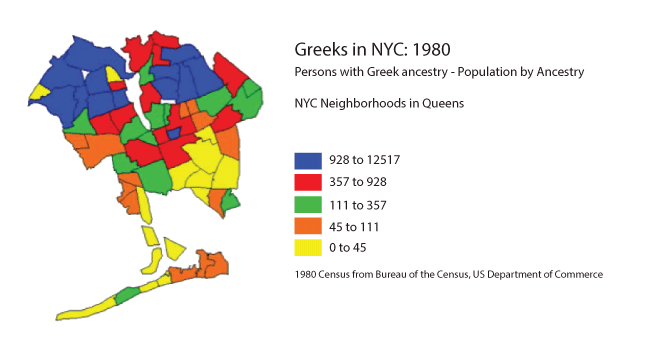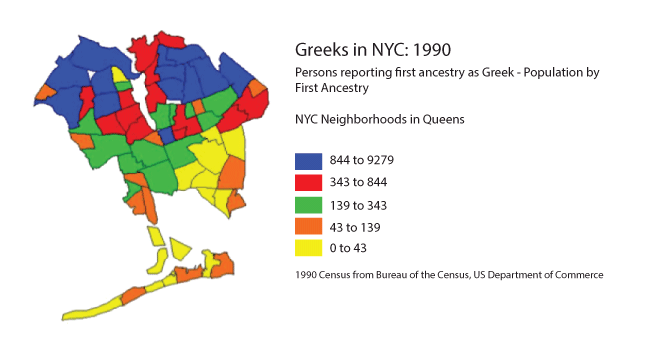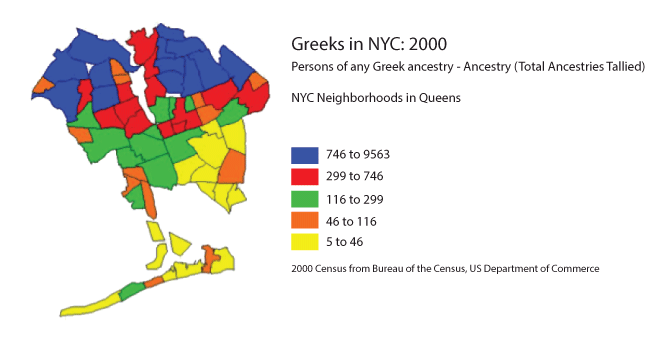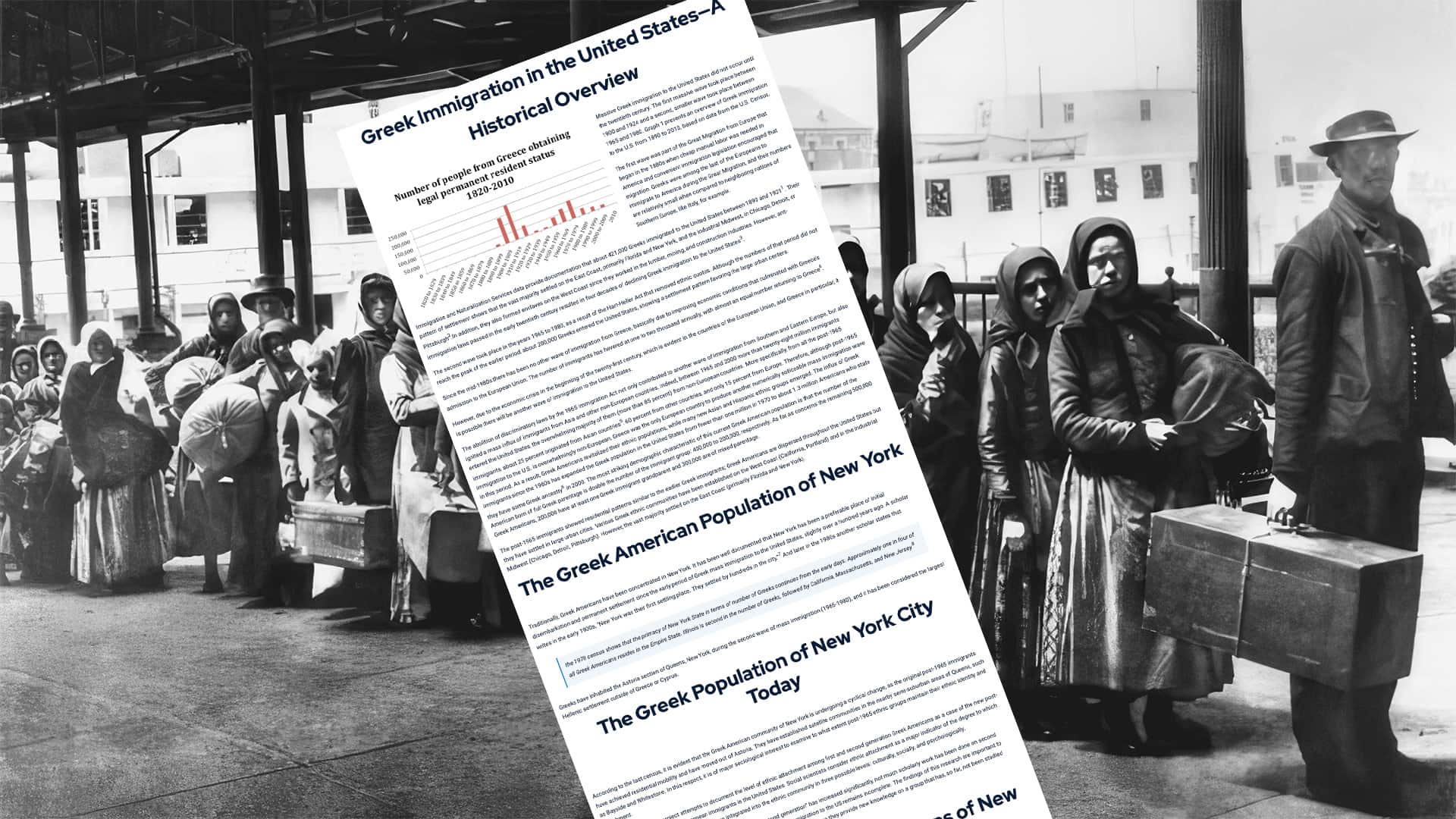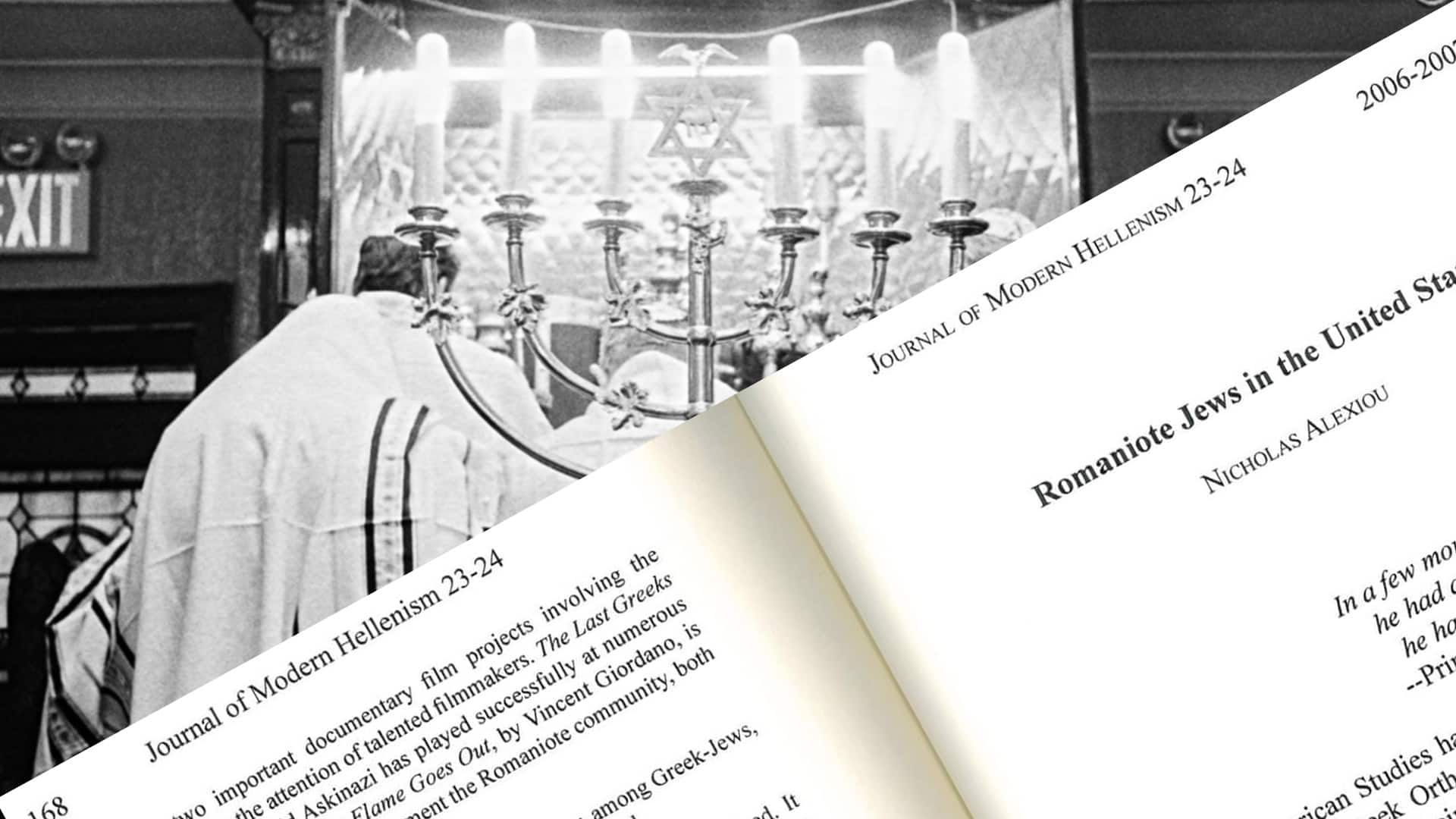By Nicholas Alexiou
Sociology Department
Queens College, CUNY
January 2013
Contents:
Greek Immigration in the United States—A Historical Overview
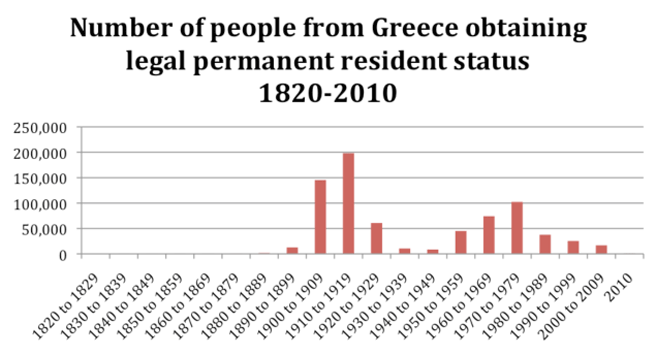 Massive Greek immigration to the United States did not occur until the twentieth century. The first massive wave took place between 1900 and 1924 and a second, smaller wave took place between 1965 and 1980. Graph 1 presents an overview of Greek immigration to the U.S. from 1890 to 2010, based on data from the U.S. Census.
Massive Greek immigration to the United States did not occur until the twentieth century. The first massive wave took place between 1900 and 1924 and a second, smaller wave took place between 1965 and 1980. Graph 1 presents an overview of Greek immigration to the U.S. from 1890 to 2010, based on data from the U.S. Census.
The first wave was part of the Great Migration from Europe that began in the 1880s when cheap manual labor was needed in America and convenient immigration legislation encouraged that migration. Greeks were among the last of the Europeans to immigrate to America during the Great Migration, and their numbers are relatively small when compared to neighboring nations of Southern Europe, like Italy, for example.
Immigration and Naturalization Services data provide documentation that about 421,000 Greeks immigrated to the United States between 1890 and 19211. Their pattern of settlement shows that the vast majority settled on the East Coast, primarily Florida and New York, and the industrial Midwest, in Chicago, Detroit, or Pittsburgh2.In addition, they also formed enclaves on the West Coast since they worked in the lumber, mining, and construction industries. However, anti-immigration laws passed in the early twentieth century resulted in four decades of declining Greek immigration to the United States3.
The second wave took place in the years 1965 to 1980, as a result of the Hart-Heller Act that removed ethnic quotas. Although the numbers of that period did not reach the peak of the earlier period, about 200,000 Greeks entered the United States, showing a settlement pattern favoring the large urban centers.
Since the mid-1980s there has been no other wave of immigration from Greece, basically due to improving economic conditions that culminated with Greece’s admission to the European Union. The number of immigrants has hovered at one to two thousand annually, with almost an equal number returning to Greece4.
However, due to the economic crisis in the beginning of the twenty-first century, which is evident in the countries of the European Union, and Greece in particular, it is possible there will be another wave of immigration to the United States.
The abolition of discriminatory laws by the 1965 Immigration Act not only contributed to another wave of immigration from Southern and Eastern Europe, but also ignited a mass influx of immigrants from Asia and other non-European countries. Indeed, between 1965 and 2000 more than twenty-eight million immigrants entered the United States, the overwhelming majority of them (more than 85 percent) from non-European countries. More specifically, from all the post-1965 immigrants, about 25 percent originated from Asian countries5, 60 percent from other countries, and only 15 percent from Europe. Therefore, although post-1965 immigration to the U.S. is overwhelmingly non-European, Greece was the only European country to produce another numerically noticeable mass immigration wave in this period. As a result, Greek Americans revitalized their ethnic populations, while many new Asian and Hispanic ethnic groups emerged. The influx of Greek immigrants since the 1960s has expanded the Greek population in the United States from fewer than one million in 1970 to about 1.3 million Americans who state they have some Greek ancestry6 in 2000. The most striking demographic characteristic of this current Greek American population is that the number of the American born of full Greek parentage is double the number of the immigrant group: 400,000 to 200,000, respectively. As far as concerns the remaining 500,000 Greek Americans, 200,000 have at least one Greek immigrant grandparent and 300,000 are of mixed parentage.
The post-1965 immigrants showed residential patterns similar to the earlier Greek immigrants; Greek Americans are dispersed throughout the United States but they have settled in large urban cities. Various Greek ethnic communities have been established on the West Coast (California, Portland) and in the industrial Midwest (Chicago, Detroit, Pittsburgh). However, the vast majority settled on the East Coast (primarily Florida and New York).
The Greek American Population of New York
Traditionally, Greek Americans have been concentrated in New York. It has been well documented that New York has been a preferable place of initial disembarkation and permanent settlement since the early period of Greek mass immigration to the United States, slightly over a hundred years ago. A scholar writes in the early 1900s, “New York was their first settling place. They settled by hundreds in the city.”7 And later in the 1980s another scholar states that
the 1970 census shows that the primacy of New York State in terms of number of Greeks continues from the early days. Approximately one in four of all Greek Americans resides in the Empire State. Illinois is second in the number of Greeks, followed by California, Massachusetts, and New Jersey.8
Greeks have inhabited the Astoria section of Queens, New York, during the second wave of mass immigration (1965-1980), and it has been considered the largest Hellenic settlement outside of Greece or Cyprus.
The Greek Population of New York City Today
According to the last census, it is evident that the Greek American community of New York is undergoing a cyclical change, as the original post-1965 immigrants have achieved residential mobility and have moved out of Astoria. They have established satellite communities in the nearby semi-suburban areas of Queens, such as Bayside and Whitestone. In this respect, it is of major sociological interest to examine to what extent post-1965 ethnic groups maintain their ethnic identity and attachment.
This present research project attempts to document the level of ethnic attachment among first and second generation Greek Americans as a case of the new post-1965 generations of Southern European immigrants in the United States. Social scientists consider ethnic attachment as a major indicator of the degree to which members of an ethnic or immigrant group are integrated into the ethnic community in three possible levels: culturally, socially, and psychologically.
Although since the late 1980s social research on the “new second generation” has increased significantly, not much scholarly work has been done on second generation Greeks. In this respect, the sociological analysis of Greek immigration to the US remains incomplete. The findings of this research are important to Greek American sociological literature and Greek American studies in general since they provide new knowledge on a group that has, so far, not been studied adequately.
Demographics – Greek Americans of New York City
According to official estimates, New York Greek Americans show an equal sex ratio: 50% males to 50% females. This is an interesting characteristic since the traditional pattern of Greek immigration, similar to other immigrant groups in America, was predominately male immigration. The median age (39 years old) is slightly higher than the national level (37 years old). At the same time, the percentage of 17-year-old and younger Greek Americans (23) is close to the national average (24). Also, the average family size of three members is similar for New York and the rest of the country, while fertility rates are slightly higher for New York Greek Americans (6.6%), when compared to the national rate of about 5%.
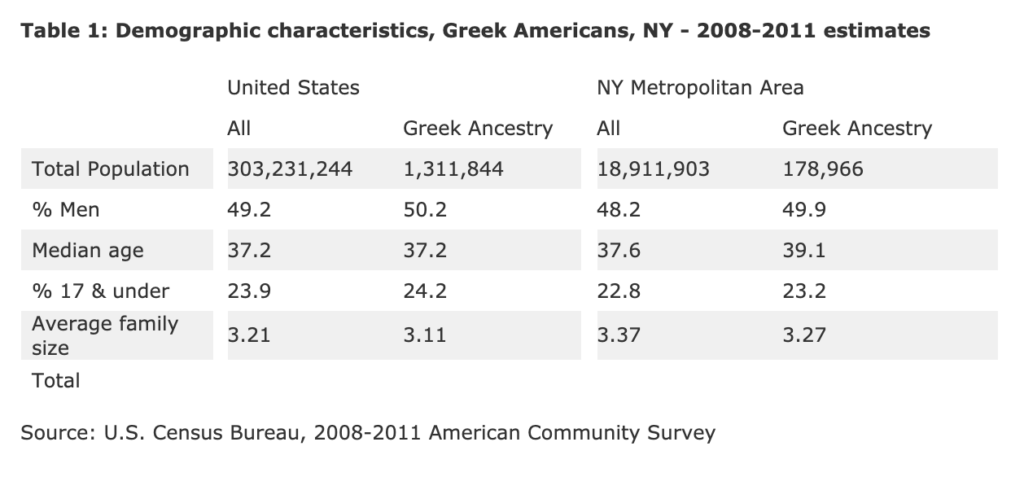
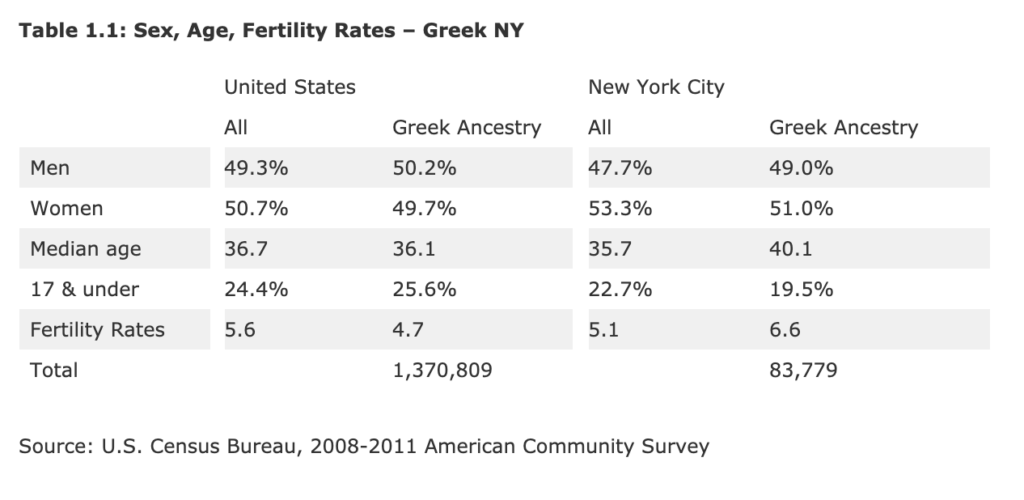
Native vs. Foreign-Born Greek
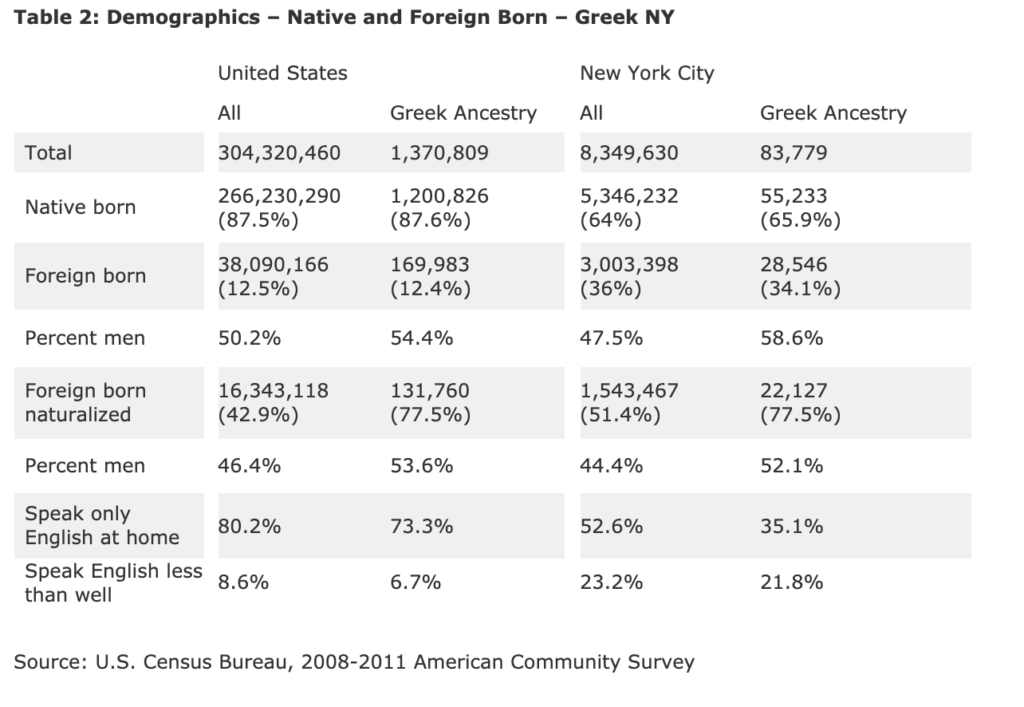
The native-born population of the United States reaches up to 87%, which is identical to the overall native-born Americans of Greek ancestry. For New York, it is of great interest that the American-born Greek population is 66%, in comparison to 34% of foreign-born Greek Americans. This is an indication of a significant transformation of the group, since it supports that the post-1965 Greeks are beyond the immigrant generation. Greek Americans are no longer an immigrant group, but an American ethnic group. Greeks are now Americans of a certain ethnic background. Of the foreign-born, Greek males have higher rates of naturalization (52%) than females (48%).
On the national level, the majority of Greek Americans speak only English at home (73%), while for New York the rate is as low as 35%. This finding supports our hypothesis that the Greek American community still has a strong cultural attachment, with lower cultural assimilation rates than Greek Americans in the rest of the United States. A sociological explanation of this is the fact that New York has received the majority of the post-1965 immigrants, who replenish the Greek population of the area.
Households by Type
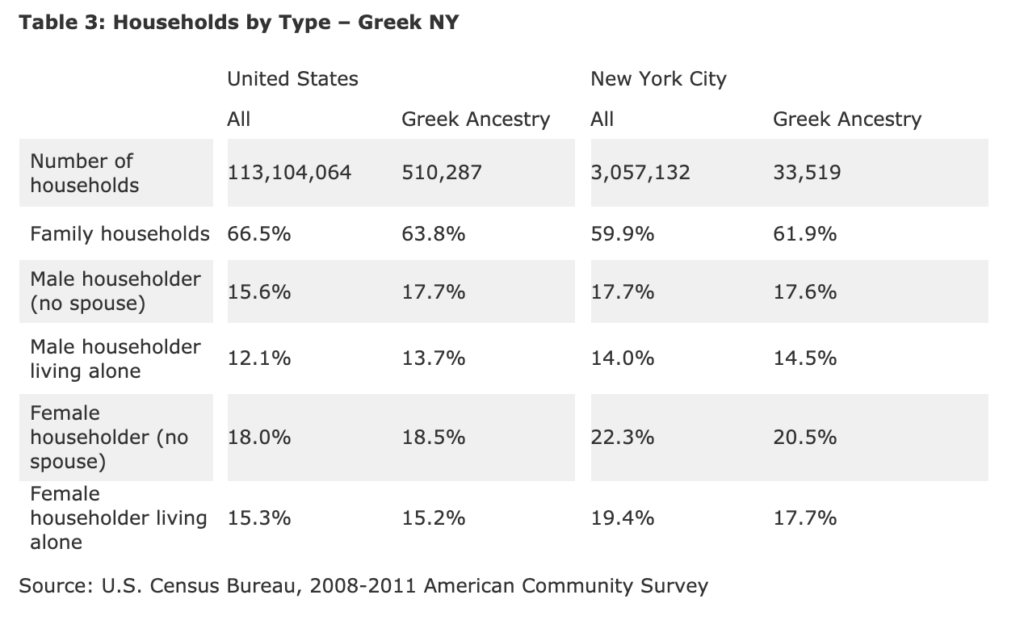
Overall, family households rates are slightly lower for New York Greeks (62%) than the national levels (64%). In addition, Greek male householders show a similarity on national and local levels of almost 18%, while females have a slightly higher percentage of 20.5%.
Marital Status
Married couple families reach a high rate of 80%, and it is similar on the national and local levels. Married Greek Americans in NY have a rate of 53%, slightly higher than the national average of 50%. Married males show a percentage of 37%. On the other hand, Greeks show slightly lower divorce/separation rates.
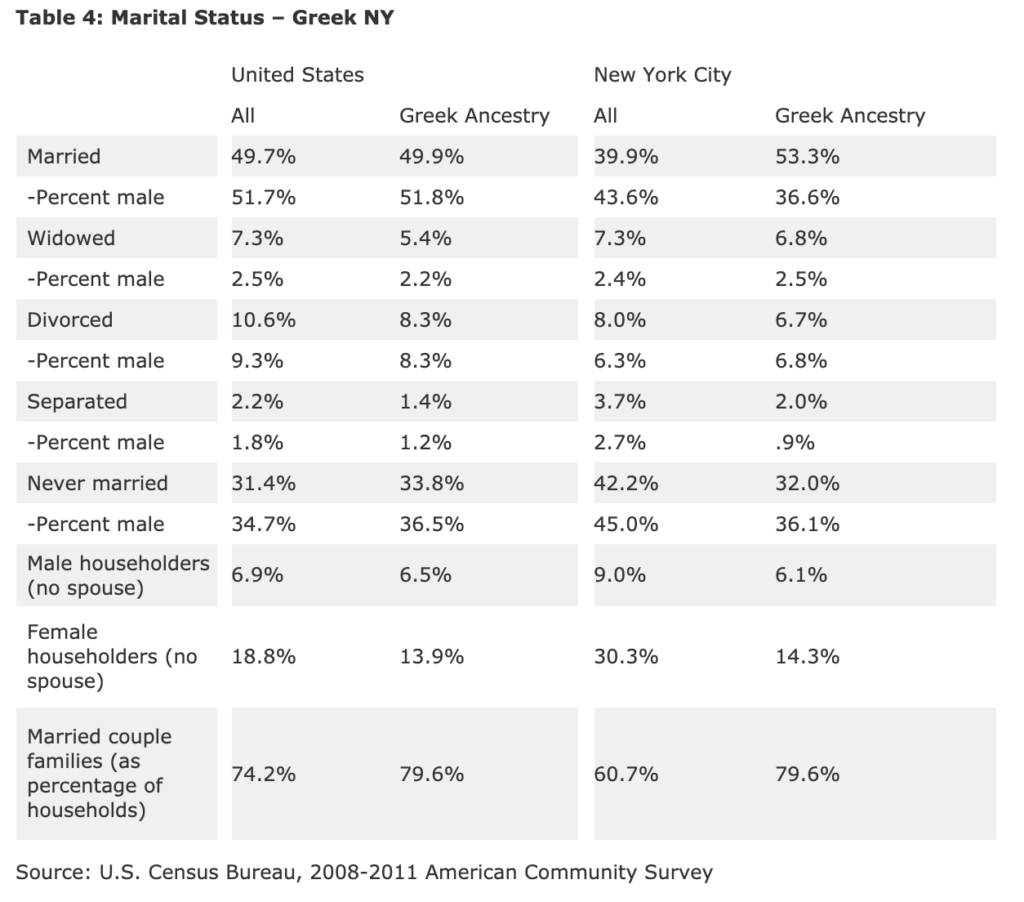
Higher Education
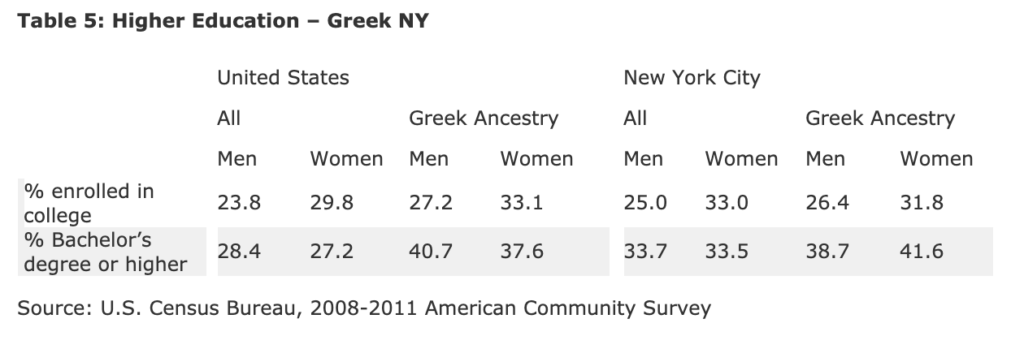
Traditionally, Greek Americans value education, and the census figures support this. Greek Americans are more likely to have a college education or higher, and it is Greek American women in New York City who show the highest percentage (42%).
Employment
More than the two-thirds of Greek Americans are in the labor force, for both New York City and the national level, and high employment rates also hold true for women in New York City (51%) when compared to the national level of 57%, or the overall American level of 55%..
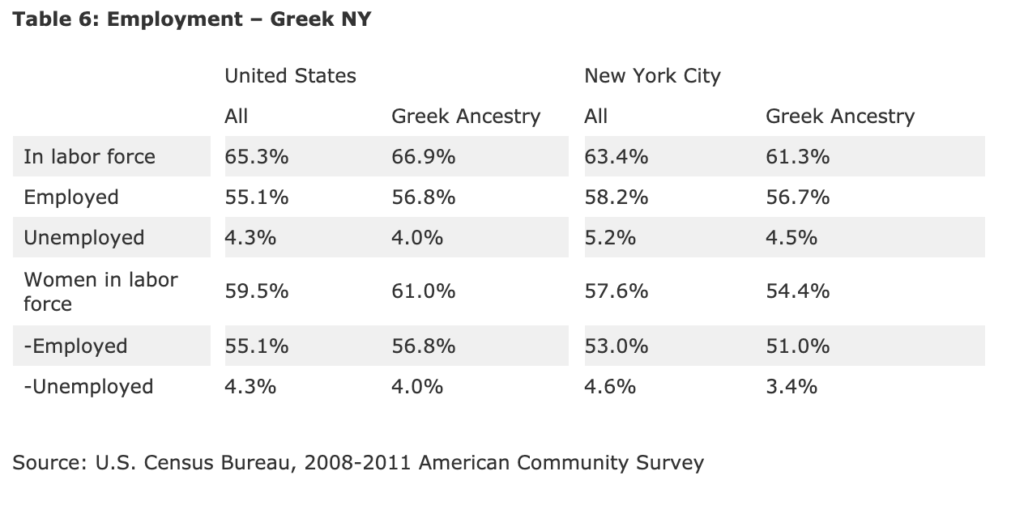
Income
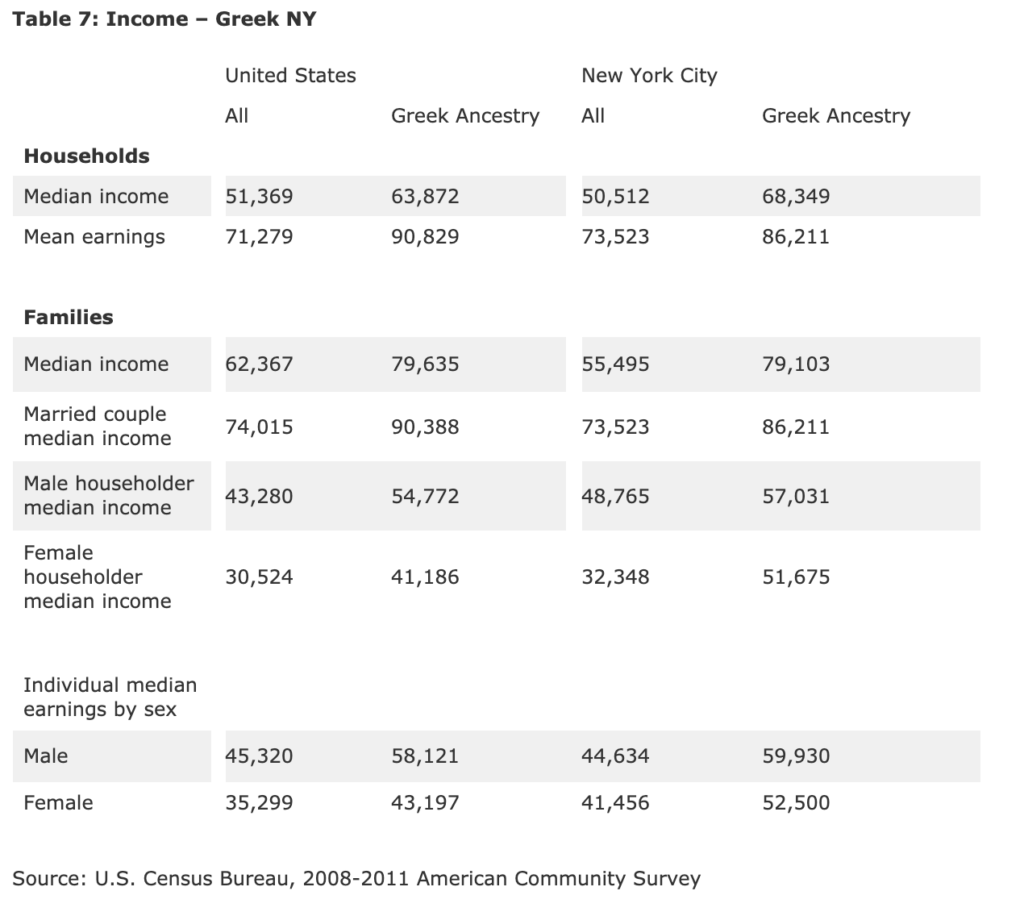
Overall, Greek Americans show a higher median income or average earnings than the general population on both the national and local levels.
Industry of Employment
Greek Americans are represented in many different industries. Greek Americans in New York City are concentrated in education/health care (24%), followed by professional/scientific (12%), and the construction industry and the arts (10%). (We should note that the American Community Survey did not include the category of food services).
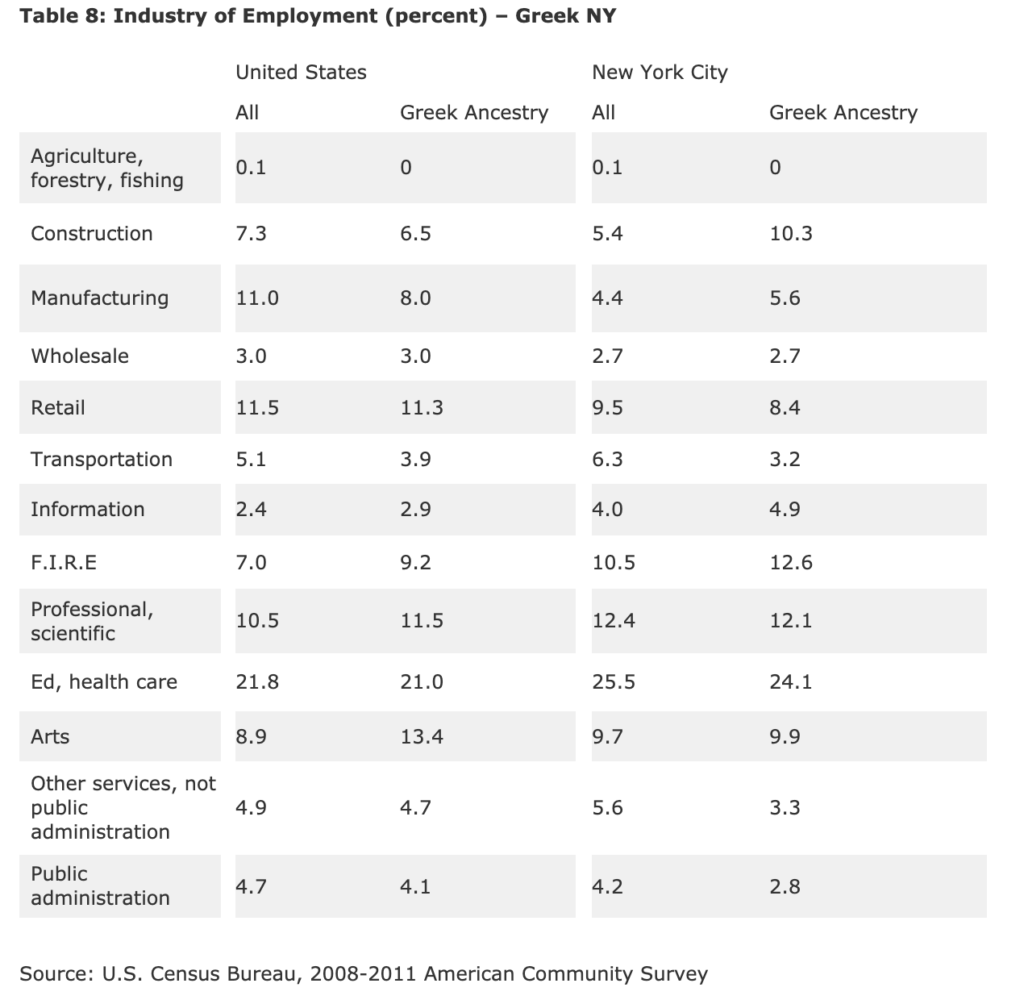
Poverty
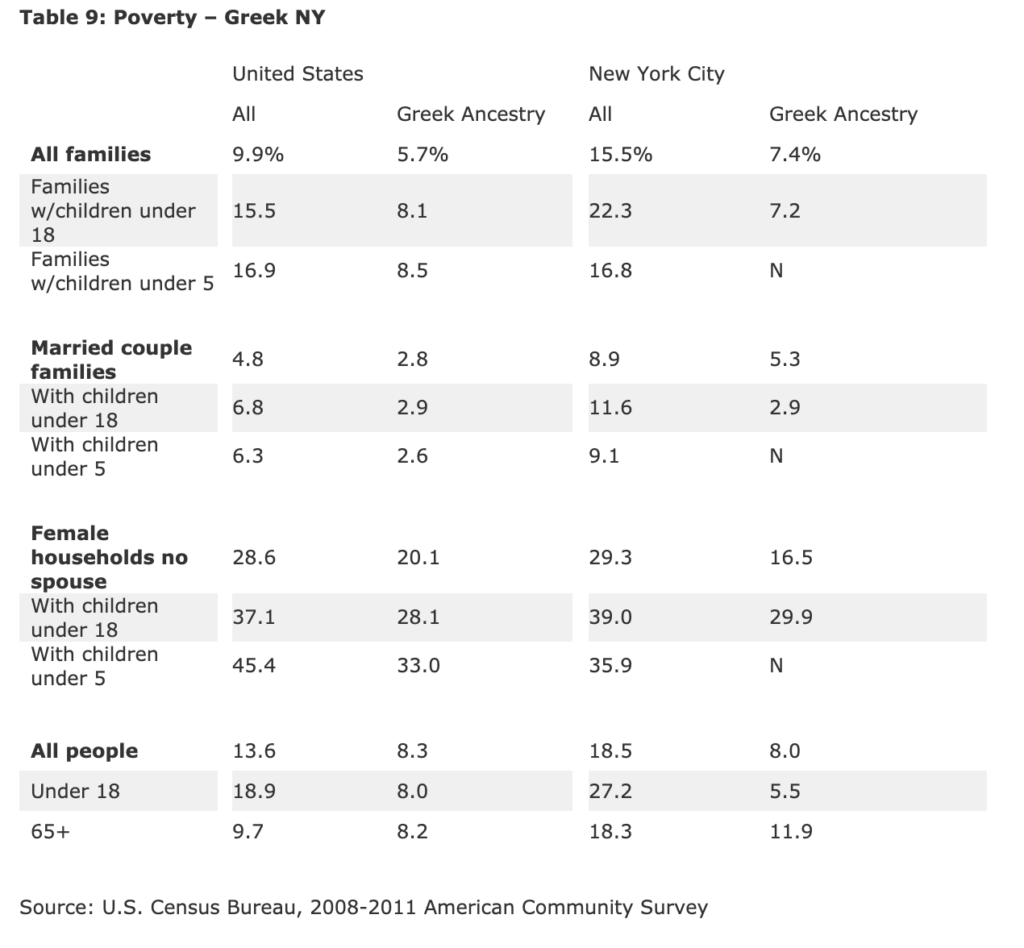
Overall, there are significant differences in poverty rates between Greek Americans and the general population at both the national and local levels. Greek Americans in New York City have a lower level of poverty in all categories. The only category with a high poverty level is for the 65+, senior citizens group, perhaps because of their work in the informal sector of the economy.
Footnotes
- 1. Immigration and Naturalization Services, Annual Report, 1976.
- 2. Dan Georgakas, Greek America at Work (NY: Greek American Labor Council, 1992).
- 3. Between 1930 and 1965 a large number of Greeks who immigrated to the US carried Ottoman, Italian, or British passports, so it is likely that the total number of immigrants in the first forty years of the century is between 600,000 and a million.
- 4. Dan Georgakas, “Now and Future Greek America,” JMH, No. 21-22, p. 13: “Greeks had among the highest return rates of all European immigrants, at least 25%, and perhaps as high as 50%.”
- 5. Pyong Gap Min, Second Generation Ethnic Identity among Asian Americans, p. 2.
- 6. US Census, 2000.
- 7. Thomas Burgess, Greeks in America (New York: Arno Press, 1970; originally published in Boston, 1913). In an article by Eva E. Sandis “The Greek Population of New York City,” 65.
- 8. Eva Sandis, 70.
References
- 1. Alexiou, Nicholas. The State of Greek American Assimilation: Towards Symbolic Ethnicity, Journal of Modern Hellenism, No. 10, 1993: 37-58.
- 2. Religious and Ethnic Identities, Theory in Action, Vol. 2, No. 4, October 2009: 77-85.
- 3. Romaniote Jews in the United States, Journal of Modern Hellenism, No. 23-24, 2006-2007: 171-181.
- 4. Burgess, Thomas. Greeks in America (NY: Arno Press, 1970; originally published in Boston, 1913).
- 5. Georgakas, Dan. Greek America at Work. NY: Greek American Labor Council, 1992.
- 6. Now and Future Greek America, JMH, No. 21-22.
- 7. Kourvetaris, George. Studies on Greek Americans. East European Monographs, 1997.
- 8. Moskos, Charles. Greek Americans: Struggle and Success. Transaction Publishers, 1989/1980.
- 9. Min, Pyong Gap. Second Generation: Ethnic Identity among Asian Americans. NY: Altamira Press, 2002.
- 10. Sandis, Eva. The Greek Population of New York City; in The Greek American Community in Transition. Ed. by Harry Psomiades and Alice Scourby. NY: Pella Publishing, 1982.
- 11. Saloutos, Theodore. The Greeks in the United States. Harvard University Press, 1964.
Appendix A
A graphical depiction of residential transformation of the Greek Americans in Queens, NY.
